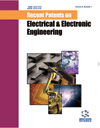- Home
- A-Z Publications
- Recent Patents on Electrical & Electronic Engineering (Formerly Recent Patents on Electrical Engineering)
- Previous Issues
- Volume 6, Issue 3, 2013
Recent Patents on Electrical & Electronic Engineering (Formerly Recent Patents on Electrical Engineering) - Volume 6, Issue 3, 2013
Volume 6, Issue 3, 2013
-
-
Recent Progress in Semiconductor Properties Engineering by Ultrasonication
More LessThis work presents review of the recent patents and applied researches in the field of ultrasonic processing of the semiconductor materials and devices. The ultrasound demonstrates selective and, simultaneously, complex character of the effect on semiconductors. In contrast to the thermal or light energy, uniformly absorbed over semiconductor volume, the acoustic wave energy is mainly absorbed by the crystal lattice defe Read More
-
-
-
Designs and Implementations of Energy-Efficient Single-Phase Clock Pass Transistor Adiabatic Logic Circuits
More LessAuthors: Yanfei Zhang and Jianping HuIn current nanometer circuits, energy consumptions of the high-performance chips have become a critical concern. Adiabatic computing reduces energy dissipations by using AC power supplies to recycle the energy stored in node capacitances of the circuits. Adiabatic logic circuits only using a single-phase power clock do not need multiple powerclock generators and complicated clock trees, and thus are easily implemented. In Read More
-
-
-
A Hybrid Model of RVM and PSO for Dissolved Gases Content Forecasting in Transformer Oil
More LessAuthors: Sheng-wei Fei, Yong He, Xiao-jian Ma and Yu-bin MiaoPrediction of dissolved gases content in power transformer oil is very significant to detect incipient failures of transformer early. A hybrid model of RVM and PSO (PRVM) is applied to predict dissolved gases content in transformer oil in this paper, and particle swarm optimization is applied to choose the appropriate embedded dimension m because the choice of the embedded dimension has a great influence on its generalizat Read More
-
-
-
Recent Patents on Fault Pattern Recognition for Motor Bearing by Multi-layer Relevance Vector Machine Classifier
More LessAuthors: Sheng-wei Fei and Chuang-xin HeFault diagnosis for motor bearing has a great economic and social significance, the patents on motor bearing fault detection and diagnosis method have been presented in the past years. However, there are some shortcomings including local extremum or over-fitting in the fault diagnosis method of these patents. Relevance vector machine (RVM), requires much fewer kernel functions compared with support vector machin Read More
-
-
-
Non-fragile Passive Filtering for Sampled-data System with Long Timedelay Subject to Nonlinearity
More LessAuthors: Shigang Wang, Yingsong Li, Yi Wu, Zhiqiang Hu, Guanda Yu, Jianxun Li and Lei GaoIn this paper, the problem of passive filtering for sampled-data system has been studied which contains nonlinear perturbation and long time delay. The nonlinear perturbation is the relationship term of state and time, and it satisfies the Lipschitz constraints. Furthermore, the direct distribution method is applied to deal with long time-delay and to relax the dimension of decision variables. The proposed passive condition assures Read More
-
-
-
Modeling the Workpiece Roughness Using Fuzzy Logic Modeling
More LessIn this paper, first order Sugeno-fuzzy logic-based models are constructed using the cutting parameters as an input data and the surface roughness (roundness) as an output data. Mapping between the input-output spaces is constructed to find the effect of the input cutting parameters on the output surface quality in terms of roundness error which is an indication of the surface roughness. Hence, the best cutting conditions in t Read More
-
-
-
Steady State Power Quality Evaluation of Grid-Connected Photovoltaic System Based on Improved Principal Component Analysis Method
More LessAuthors: Ji-dong Wang, Li-peng Wang and Xi-pin PangThe comprehensive quantified evaluation of power quality is one of the main foundations in power quality appraisal. This paper presents the improved principal component analysis (PCA) method to evaluate steady state power quality of grid-connected photovoltaic system synthetically. Some improvements are made to traditional PCA method for the purpose of taking subjective factors into account and normalizing the f Read More
-
Volumes & issues
Most Read This Month
Article
content/journals/eeng
Journal
10
5
false
en


